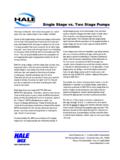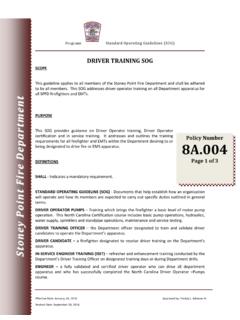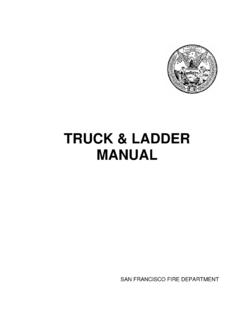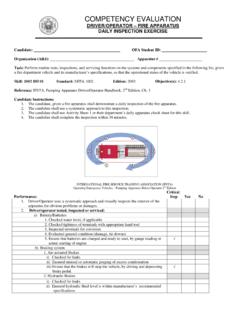Transcription of GENERAL INFORMATION - LA County Firefighters
1 GENERAL INFORMATION 2 Air Horn Siren Federal Q2B Specifications Chassis: Predator MFD w/ Flat Roof Engine: Cummins ISM 500-HP w/ Compression Brake Transmission: Allison 4500 EVS Front Axle: Meritor MFS-20133A-N; #21,480 Rear Axle: Eaton S30-190; #31,000 Trailer Axle: Meritor FL-941; #23,000 Pump: Waterous S-100-200, 1500 GPM Single Stage Tank: 350 Gallon Stainless Steel The 2010 KME Aerialcat 100 training guide / operating manual has been developed with Los Angeles County and KME Manuals along with NFPA Standards 1901, Physics of Aerials For Operators by Jim Burrell and the LA County fire Shops technical assistance. Whelen SA122 FM Siren Speaker Anchor Points Wig Wag Headlights Wiper Motor Access Panel Chrome Plated Uni-ty 225 Spotlights West Coast Mirrors w/ Aux Convex Code 3 Lightbars Sigtronics Intercom System Class 1 Total System Manager 2010 KME AERIALCAT 100 GENERAL INFORMATION Not for Towing 3 NFPA Standard 1901, Roadability The maximum top speed of fire apparatus with a GVWR over 26,000 lb shall not exceed either 68 mph or the manufacturer s maximum fire service speed rating for the tires installed on the apparatus , whichever is lower.
2 If the combined water tank and foam agent tank capacities on the fire apparatus exceed 1250 gal, or the GVWR of the vehicle is over 50,000 lb, the maximum top speed of the apparatus shall not exceed either 60 mph or the manufacturer s maximum fire service speed rating for the tires installed on the apparatus , whichever is lower. Measured from the siren to the rear tow eye 55 - 8 11/16 long 104 Tractor 301 94 Center Wheel to Siren 164 Wheel to Wheel 312 Wheel to Wheel Weight Distribution Analysis FRONT REAR TRAILER TOTAL GVWR 21,480 31,000 23,000 75,480 Unladed Weight 18,440 25,760 17,500 61,700 Fully Loaded Weight 19,100 30,100 21,730 71,230 Weight Distribution 27% 43% 30% 100% Note: Unladed weight does not include the weights of NFPA equipment, personnel or water Note.
3 Weight Distribution is calculated for a fully loaded vehicle Wall to Wall Turning Radius: 59 -5 Curb to Curb Turning Radius: 52 -2 2010 KME AERIALCAT 100 GENERAL INFORMATION 70 Gallon Steel Fuel Tank Discharges: 1- 2-1/2 Left Side w / 2 1/2 Reducer and Cap 1 3 Right Side w / 4 x 2 1/2 Reducer and Cap 2 2 1/2 Crosslays, Centered Below Hosebeds 4 Excessively uneven loading from side to side (greater than 550 lbs.) can cause the vehi-cle to pull to one side during braking and/or produce a reduction in the rollover threshold of the vehicle. Operation of an improperly loaded vehicle could lead to loss of vehicle control causing property damage, serious personal injury, or death. NFPA Standard 1901, Load Distribution The manufacturer shall engineer the fire apparatus to comply with the gross axle weight ratings (GAWR), the overall gross vehicle weight rating (GVWR), and the chassis manufacturer s load balance guide -lines.
4 The fire apparatus , as supplied by the manufacturer, shall have a side to side tire load variation of no more than 7 percent of the total tire load for that axle or the limits allowed by the axle or component manufac-turer. Compartment Opening Sizes 2010 KME AERIALCAT 100 GENERAL INFORMATION 5 Overall travel height 138 (11 - 6 ) Tiller Cab 42 Wide Tiller Cab 56 Tall Travel width101 Measured from the outside of each jack the outriggers are custom dimensions for LA County at 15 - 6 wide, due to narrow streets. Normal outrigger dimensions are 16 feet. Ground Ladders 2 - Alaco 35 2 Section Extension; WX071392-35 1 - Alaco 24 Double End Truss Wall; WXO1069-24 2 - Alaco 20 Double End Truss Wall; WXO10695-20 1 - Alaco 16 Double End Truss Wall; WXO10695-16 1 - Alaco 20 Trussed Roof w/ Hooks; WXOO71492-20 1 - Alaco 16 Trussed Roof w/ Hooks; WXOO71492-16 1 - Alaco 14 2-Section Baby Banger; 2301-14 1 - Alaco 12 Telephone Combination; 1600F-12 (Body Mounted) 1 - Alaco 10 Collapsible Attic Ladder; 2305-101 Rear Compartment Dimensions 2010 KME AERIALCAT 100 GENERAL INFORMATION 6 NFPA 1901 committee is composed of a diverse group of interested parties: of the 30 principal voting mem-bers, about 1/3 represent the fire service, about 1/3 represent the manufacturers and the last 1/3 represent others, like representatives from mechanics organizations, insurance companies, etc.
5 The principal members span the breadth of climate, environment and geography flat-landers, mountainous and coastal country, places with ice and snow and places hot enough to fry an egg on diamond-plate. The NFPA collects recom-mendations for changes to the standards and the committee meets twice a year to discuss and debate the requested changes for inclusion. Anyone can submit changes to the standards, just fill out the form at the back of every NFPA standard, identifying who the submitter is, the standard and section number of interest, the suggested changes and the justification for the suggested changes. In this way, the public has access to the standards process. Altogether, the NFPA standards represent a process, diverse in nature and interest with public accessibility, attempting to establish fair and reasonable measures of common sense and safe op-erating procedures. The question arises, are the NFPA standards law ?
6 In most states, the answer is NO they are only recom-mended, as in California. So how relevant are they? Basically, the NFPA standards represent a vanilla version of what is determined to be a minimum safe lev-el of operation. The justice system uses the standards as the measure of common sense . The argument has two approach-es, first, the justice system goes back to 1856 (Blyth vs Birmingham Water Works) defining the Reasonable and Prudent Man as: Negligence is the omission to do something which a reasonable man, guided upon those considerations which ordinarily regulate the conduct of human affairs, would do, or do something which a prudent and rea-sonable man would not do. In1986, the NTSB got involved in the investigation of a number of accidents that involved fatalities dealing with emergency vehicles. Their conclusion was that in every case the vehicles showed deficiencies in their maintenance that contributed to the accidents, in most cases brakes.
7 Following the NTSB s report, a second-ary report was produced that surveyed over 600 departments that concluded over 60% of the vehicles were not in compliance with OEM recommendations or DOT regulations. Essentially, the NTSB put pressure on the fire service indicating they had better upgrade their maintenance standards or be prepared to have the gov-ernment get involved. To that end, starting in 1990, the NFPA had its 1901 committee start the process of generating a new maintenance standard. In 2000, NFPA 1915 was adopted and in 2007, the various stand-ards dealing with maintenance, inspections, performance and refurbishment are folded together as a new combined standard NFPA 1911 2007. To resolve the three conditions mentioned above, there are three avenues of action: i. The ladder needs to be designed to resist catastrophic failure using the knowledge of how materials fail, how columns fail and how stresses are transferred through the structure.
8 Ii. Establish and follow the rules that is, NFPA standards. iii. Manuals from manufacturer that establish inspection, maintenance and testing criteria and standards. 2010 KME AERIALCAT 100 GENERAL INFORMATION 7













